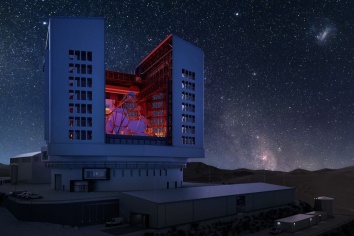
Rendering of the Giant Magellan Telescope. Image credit: IDOM / Giant Magellan Telescope, GMTO Corporation.
13 June 2024
The University of Texas at Austin joined Giant Magellan Telescope and IDOM today in announcing that the telescope’s enclosure, set to be one of the world’s largest astronomical facilities, passed its final design review and is now ready for construction in Chile. The review marks a major milestone for the telescope, which is now 40% under construction and on track to be operational by the early 2030s.
“A team of ten international subject matter experts validated two years of design work by IDOM and the Giant Magellan Telescope. The final design of the enclosure is unique and an important feat of technical management, design, and engineering. We are very grateful for the committee’s professional assessment as we proceed towards construction,” said Bruce Bigelow, the site infrastructure, enclosure, and facilities manager for the Giant Magellan Telescope. “We’re also incredibly excited to be moving towards the procurement stage, where we will begin soliciting proposals to begin construction.”
Once completed, the 213-foot-tall (65-meter-tall) enclosure will be one of the largest mechanized buildings ever constructed and will represent a true feat of modern engineering and precision manufacturing. At over 5,000 metric tons, the enclosure will be able to complete a full rotation in four minutes and be equipped with 46-meter-tall shutter doors that reveal the 83-foot (25.4-meter) telescope for unobstructed scientific observations. The smart building is cleverly designed to control the telescope’s operating environment by protecting seven of the world’s largest mirrors as they track celestial objects across the sky more than a billion light years away.
“The Giant Magellan Telescope is truly a triumph on all levels. From the international collaboration behind its funding and design, to the development of its cutting-edge components, to the ground-breaking science it will enable,” said Taft Armandroff, director of UT Austin’s McDonald Observatory, which is one of the telescope’s founding partners. “We are delighted that this modern marvel is one step closer to completion.”
Following the successful conceptual design of the European Southern Observatory’s Extremely Large Telescope dome, IDOM continues to make important contributions to the design of astronomical facilities with the Giant Magellan Telescope—built by an American-led international consortium of 14 universities and research institutions. The breadth of talent afforded by the consortium is stimulating America’s economy with construction, testing, and design work on the telescope in 36 states.
“We formed a strong and productive partnership with IDOM as the enclosure designer. Their well-known architectural accomplishments combined with their engineering expertise in large and complex movable structures has been critical to the design of this unique structure,” said Giant Magellan Project Manager William Burgett. “The dedication and attention to detail that the IDOM team has demonstrated has been instrumental on our way to becoming one of the most powerful ground-based telescopes in the world.”
IDOM began developing the Giant Magellan Telescope enclosure design over two years ago following a competitive, global search and extensive evaluation process.
“Our team approached the challenge of the Giant Magellan Telescope enclosure knowing that this structure would be responsible for enabling some of the most important scientific discoveries of our lifetimes,” said IDOM North American President Tom Lorentz. “We are proud to have delivered a successful design and look forward to the Giant Magellan Telescope’s success.”
Construction of the telescope components housed within the enclosure are advancing rapidly. For example, over the past year, fabrication commenced on the seventh and final primary mirror in Arizona, while manufacturing of the 128-foot-tall (39-meter-tall) mount structure began in Illinois. Other advancements include near completion of the telescope’s first adaptive secondary mirror and significant progress on a suite of high-resolution imagers and spectrographs in Arizona, California, Massachusetts, and Texas.
These optical technologies will enable the Giant Magellan to boast a remarkable tenfold increase in resolution compared to the Hubble Space Telescope and deliver up to 200 times the power of today’s best telescopes. The breakthrough technologies will empower scientists worldwide, offering unparalleled insights into the evolution of the universe, the origins of chemical elements, and the discovery of life on distant exoplanets for the first time.
With the enclosure design milestone complete, the Giant Magellan Telescope is now preparing a global search for a firm to leave their mark on the future of astronomy with construction of the enclosure.

Rendering of the Giant Magellan Telescope. Image credit: IDOM / Giant Magellan Telescope, GMTO Corporation.